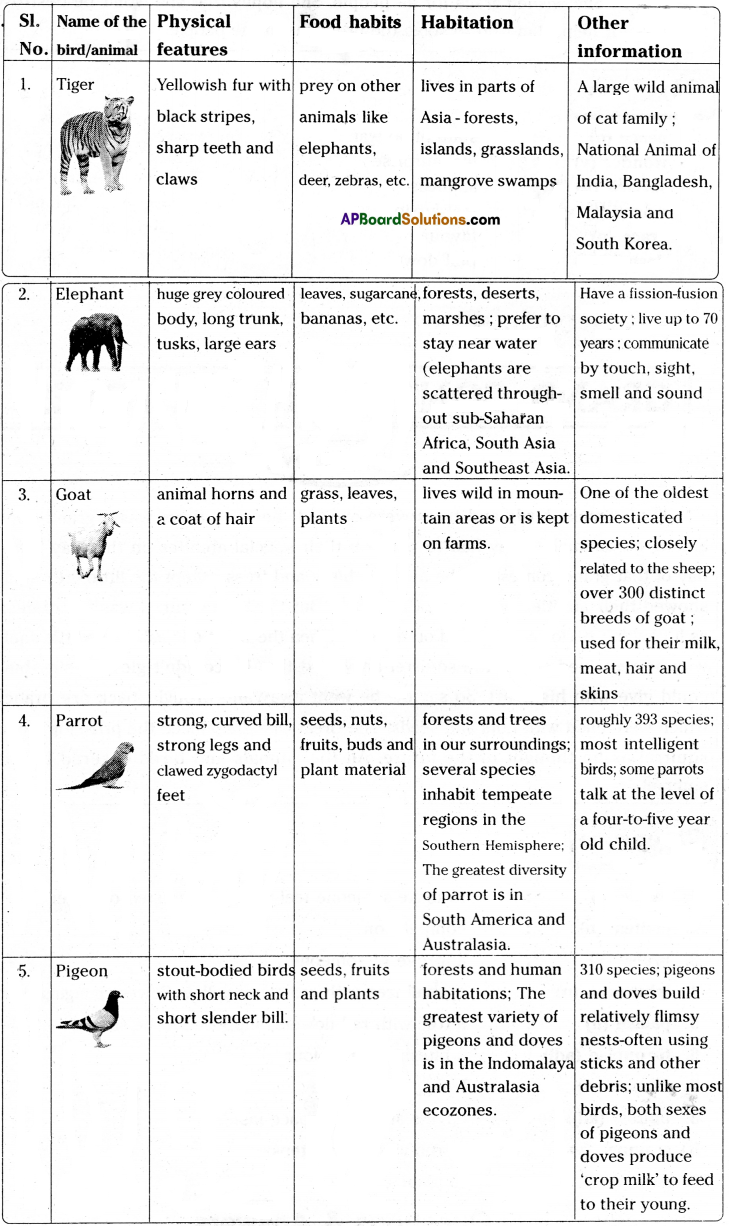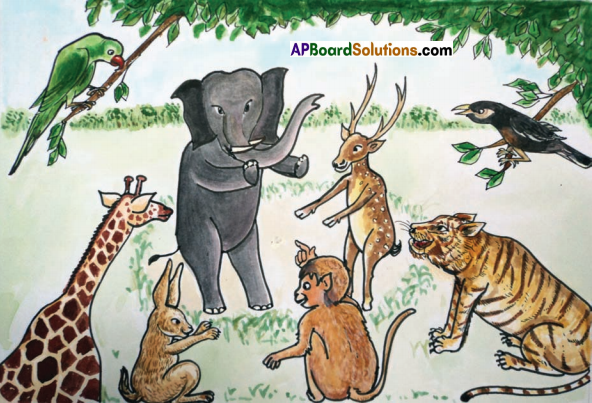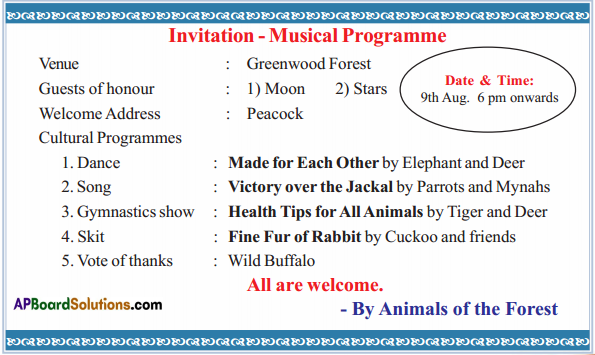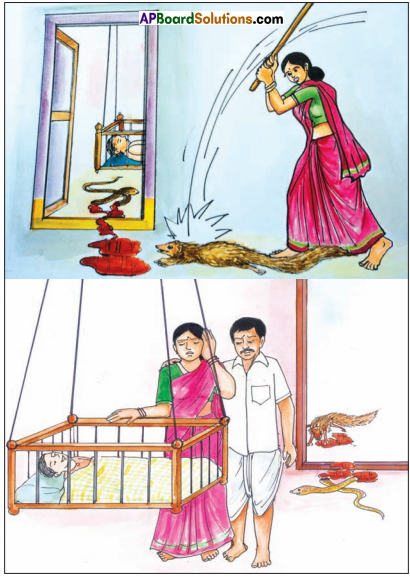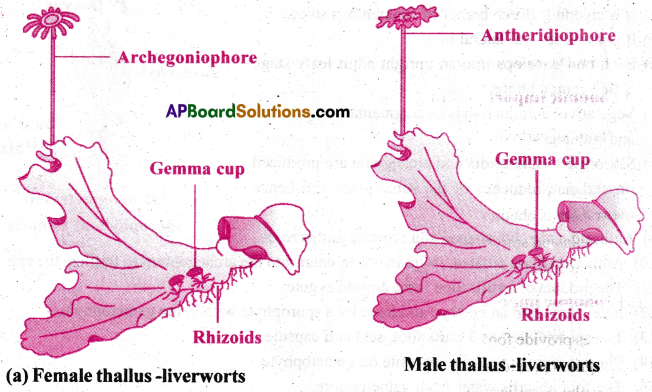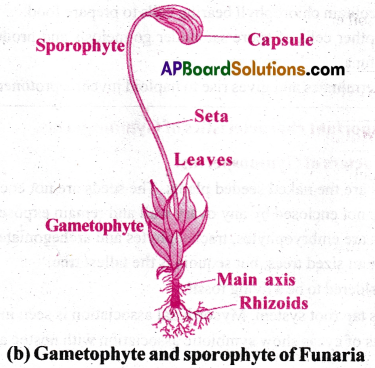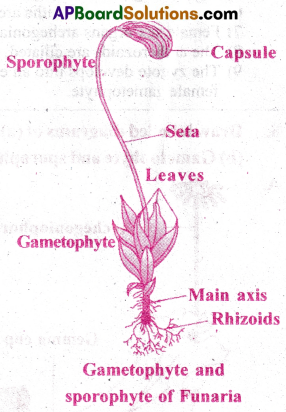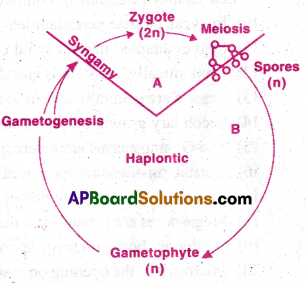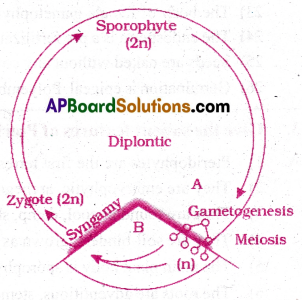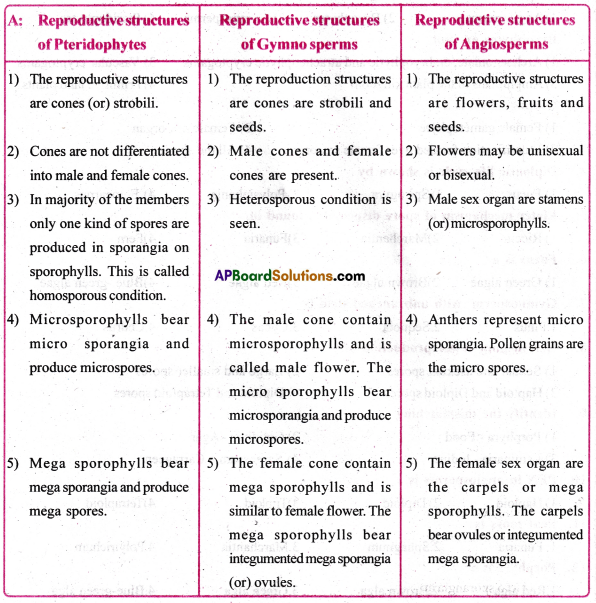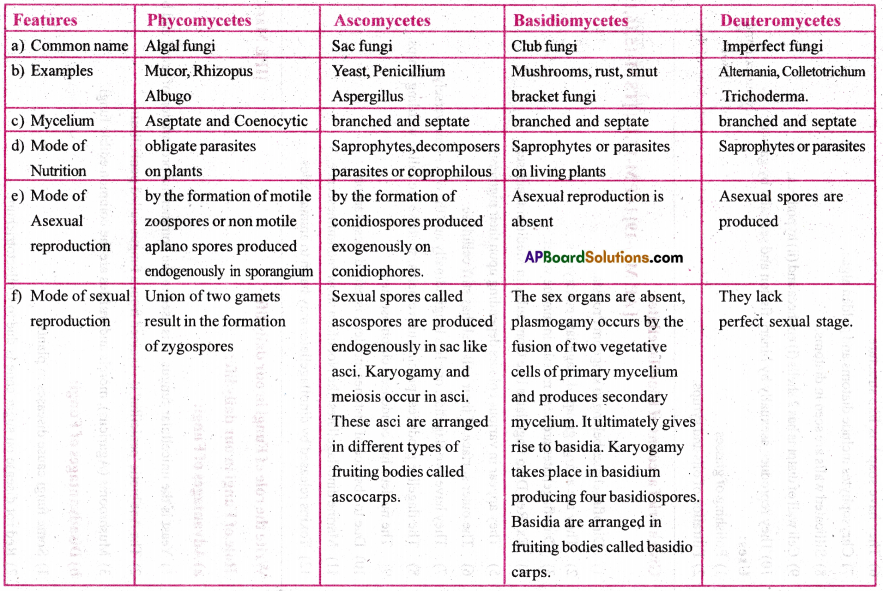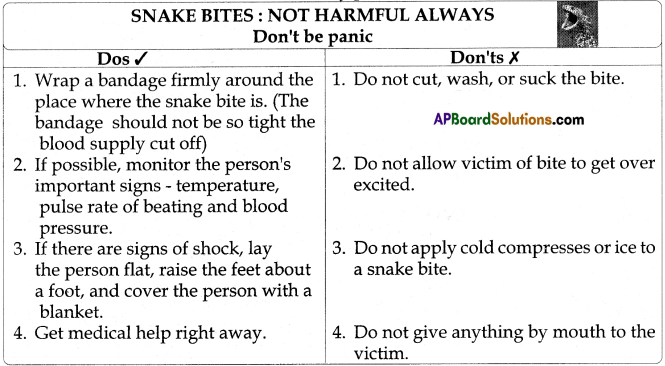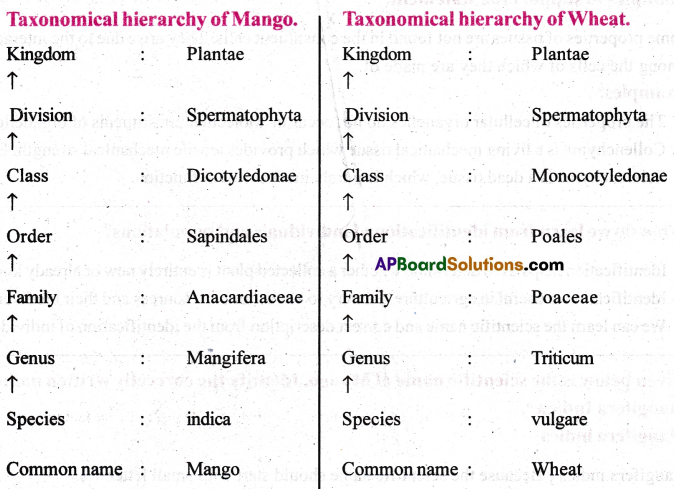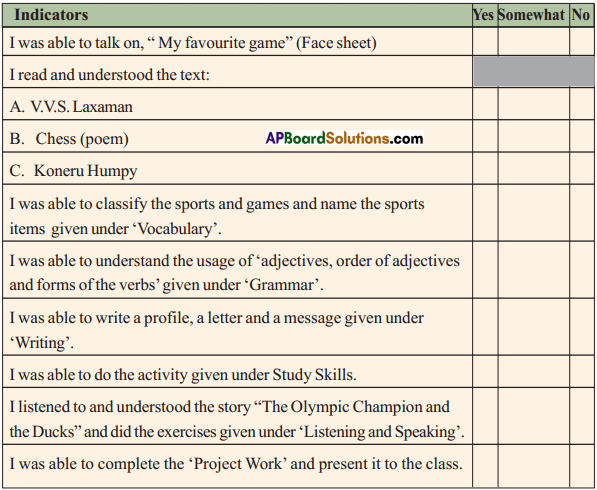Telangana SCERT TS 6th Class English Study Material Pdf Unit 1C Grand Contest in the Forest Textbook Questions and Answers.
TS 7th Class English Guide Unit 1C Grand Contest in the Forest
Questions & Answers:
Answer the following questions.
Question 1.
“There was excitement in the air.” Why ?
There was going to be a grand contest. In that contest every animal, bird and tree should show something special. So there was the excitement in the air.
Question 2.
Who will sing a song ?
Answer:
The lark will sing a song.
Question 3.
How was the squirrel ? Why ?
Answer:
The squirrel was sad. He thought that he didn’t glow or sing. He didn’t have any special ability to perform. So he was sad.
Question 4.
Who was the winner of the contest ?
Answer:
The winner of the contest was the little grey squirrel.
Question 5.
Why did the Great One give prize to the squirrel ?
Answer:
The Great One thought that the little squirrel thought of the future while the others thought of only the present. So, the Great One gave the prize to the squirrel.
Question 6.
If you were the judge, who would get the prize ? Why ? Give reasons for your answer.
Answer:
If I were the judge, the same little grey squirrel would get the prize. He filled the dry branches with nuts and seeds. We can plant the seeds and the new plants and trees will bear fruit and other eatables. So I would judge that he was the winner.
![]()
Grand Contest in the Forest Summary in English
The animals, birds and trees were excited because there was a grand contest among the animals. They had to perform their special abilities on that day. On the day of that grand contest all the animals, birds and trees except the little grey squirrel showed their abilities before the Great One. But the little squirrel was full of despair as it couldn’t perform any grand on the day. When the Great one asked the little squirrel why he remained silent, the squirrel answered that he couldn’t glow or sing but he could give with his heart. So saying, he went away and brought back dry branches which were filled with nuts and seeds. The Great One announced the prize for the little squirrel as he thought of the future. All the animals and birds cheered the little squirrel.
Glossary:
1. excite (v) : to make someone feel happy, interested or eager
2. contest (n) : competition
3. praise (v) : approve of someone
4. laburnum : a small tree with groups of yellow flowers hanging down
5. palash (n) : a tree with red flowers, supposed to be sacred
6. turquoise (adj) : a bluish green colour
7. despair (n) : feeling of no hope
8. hollow (adj) : having an empty space inside
9. scamper (v) : to run with quick steps
10. sow (v) : to plant
![]()
Section – A : Reading Comprehension (25 Marks)
Questions: 1 – 10 (Marks : 15)
Passage No. 1:
1. Read the following passage.
Once upon a time, in a very thick forest there lived many animals, birds, snakes and insects. They all lived together happily. They roamed about the jungle, and played together in the open fields without any fear. The peacocks were very proud of their dances but admired the melodious songs of the cuckoos. The elephants enjoyed watching the fish swimming in the pool. The pythons which were blessed with long bodies, spoke well of the fine fur of the flat-footed rabbits. The tiny ants, which were always busy, tickled the dark buffaloes.
They often held musical evenings in a large open field. The elephant and the deer danced. The mynahs and the parrots sang. The tiger and the bear exhibited gymnastics. They called the moon and his friends, the stars, to be the guests of honour at their musical evenings.
Now, answer the following questions. Each question has four choices. Choose the correct answer and write (A), (B), (C) or (D) in your answer booklet. 5 × 1 = 5
Question 1.
How did the animals live according to the passage ? ( )
A) peacefully
B) harmoniously
C) happily
D) all the above
Answer:
D) all the above
Question 2.
Who did the peacocks admire ? ( )
A) their own dances
B) melodious songs of cuckoos
C) swimming fish
D) elephant’s dance
Answer:
B) melodious songs of cuckoos
Question 3.
What did the tiny ants do ? ( )
A) tickled the elephants
B) tickled the pythons
C) tickled the dark buffaloes
D) tickled the rabbits
Answer:
C) tickled the dark buffaloes
Question 4.
What did the elephants enjoy ? ( )
A) watching the fish swimming in the pool
B) melodious songs of cuckoos
C) peacock dances
D) their own dance
Answer:
A) watching the fish swimming in the pool
Question 5.
Pick out the word which is opposite to ‘leisurely’ from the passage. ( )
A) busy
B) proud
C) honour
D) admired
Answer:
A) busy
![]()
Answer the following questions in two or three sentences each. 5 × 2 = 10
Question 6.
How did the animals roam in the forest ?
Answer:
The animals roamed about the jungle, and played together in the open fields without any fear.
Question 7.
Why did the creatures hold musical evenings in the forest ?
Answer:
The creatures held musical evenings to enjoy the occasion among themselves and to depict peace and harmony existed among them.
Question 8.
Who were the invitees to be the guests of honour at musical evenings ?
Answer:
Moon and his friends, the stars were the invitees to be the guests of honour at their musical evenings.
Question 9.
Where did they hold musical evenings ?
Answer:
They held musical evenings in a large open field.
Question 10.
Mention the cultural programmes that were held in their musical evenings.
Answer:
The elephant and the deer danced. The mynahs and the parrots sang. The tiger and the bear exhibited gymnastics.
![]()
Passage No. 2:
2. Read the following passage.
One day a jackal entered the forest. He was dirty, dangerous, and very cunning too. He told the elephants, “You are the biggest animals in the forest. Why do you want to play with the squirrels and the rabbits?” He poisoned the minds of the peacocks saying, “You are the loveliest birds in the forest. Why do you want to praise the mynahs?” The jackal then approached the deer and whispered that the tiger was waiting for a chance to kill them.
Gradually, all the animals began suspecting one another. Earlier they had lived together, slept together and roamed around the forest together. Now they started to put up boundaries and build fences around their properties. They moved about individually or with their own group.
Now, answer the following questions. Each question has four choices. Choose the correct answer and write (A), (B), (C) or (D) in your answer booklet. 5 × 1 = 5
Question 1.
The jackal was ________ ( )
A) dirty
B) dangerous
C) very cunning
D) all the above
Answer:
D) all the above
Question 2.
Who is the biggest animal in the forest ? ( )
A) Elephant
B) Lion
C) Tiger
D) Bear
Answer:
A) Elephant
Question 3.
________ was playing with squirrels and the rabbits. ( )
A) Elephant
B) Lion
C) Tiger
D) Bear
Answer:
A) Elephant
Question 4.
What did the jackal do after entering the forest ?
A) poisoned the minds of the animals and birds
B) roamed about the jungle without fear
C) played with all animals
D) lived happily
Answer:
A) poisoned the minds of the animals and birds
Question 5.
The loveliest bird in the forest is ……………. ( )
A) Peacock
B) Mynah
C) Parrot
D) Cuckoo
Answer:
A) Peacock
![]()
Answer the following questions in two or three sentences each.
Question 6.
‘Peacocks praised the mynahs.’ What character trait of peacock do you observe from the above sentence. What skill do you want to develop from the peacock ?
Answer:
I observed modesty in peacock. I develop appreciating skill from the peacock.
Question 7.
What did the jackal try to do in the above passage ?
Answer:
The jackal wanted to bring differences among the creatures of the forest by poisoning their minds.
Question 8.
What did the jackal whisper in the deer’s ear ?
Answer:
The jackal whispered in the deer’s ear that the tiger was waiting for a chance to kill them.
Question 9.
Did the animals believe the jackal’s words ? What was the consequence ?
Answer:
Yes, they believed the jackal’s words. They started suspecting one another. They moved about individually.
Question 10.
Can you guess why the jackal behaved as mentioned in the passage ?
Answer:
The jackal wanted to kill the smaller animals and birds by creating some differences among them. If they were united, it was not possible for the jackal to kill them.
![]()
Passage No. 3:
3. Read the following passage.
Now it was easy for the jackal to hunt the smaller animals and the birds. And when the smaller ones cried out for help, no one came to help them. One by one, the little ones disappeared. The forest slept as the animals were afraid. There were no more musical evenings. The moon was sad. He cried.
The moon thought for a while and decided to come down among the animals and the birds as a sadhu. As soon as the sadhii appeared in the forest, the animals and the birds approached him to narrate their tales of woe. They cried, sobbed and blamed each other for disturbing the peace in the forest. And the sadhu listened to them.
The sadhu brought together the lions and the rabbits for a common meal. He visited the python and the viper, and had a long chat with them. He advised the eagle not to attack the little chicks that had lost their mother. The sadhu accompanied the tiger and the wild bear to the nearest market. He played with the bulbul, the owl and the monkeys.
Now, answer the following questions. Each question has four choices. Choose the correct answer and write (A), (B), (C) or (D) in your answer booldet. 5 × 1 = 5
Question 1.
Now it was easy for the jackal to hunt the smaller animals and the birds because ________ ( )
A) all the animals began suspecting one another.
B) peace and harmony among the animals was disturbed.
C) they started to move individually.
D) all the above
Answer:
D) all the above
Question 2.
Why did the little ones disappear ?
A) because the jackal killed one by one
B) because they flee to another forest
C) because the bigger animals hunted all the little ones
D) they slept as they were afraid
Answer:
A) because the jackal killed one by one
Question 3.
The moon was sad because ________ ( )
A) there were no musical nights.
B) the animals did not invite him as a guest of honour.
C) the animals did not give respect to him.
D) peace and harmony among the animals was disturbed and they began to live individually.
Answer:
D) peace and harmony among the animals was disturbed and they began to live individually.
Question 4.
The sadhu brought together the lions and the rabbits for a common meal ________ ( )
A) to teach them to live in peace and harmony. ( )
B) to ask them to conduct musical nights.
C) to ask them to call him as a guest of honour.
D) to praise the lion and the rabbit.
Answer:
A) to teach them to live in peace and harmony.
Question 5.
What did the sadhu listen ? ( )
A) Animals’ tales of woe
B) Cuckoo’s song
C) Parrot’s talk
D) Mynah’s words
Answer:
A) Animals’ tales of woe
![]()
Answer the following questions in two or three sentences each. 5 × 2 = 10
Question 6.
Why did no one come to help the smaller animals when they cried out for help ?
Answer:
All the animals started thinking that the other animals were their enemies. So when the smaller animals cried out for help no one came.
Question 7.
Why did the moon come to the earth ?
Answer:
The moon came to the earth to restore peace and harmony in the forest. He wanted to save the lives of the animals from the jackal.
Question 8.
What did the animals do when they saw the sadhu in the forest ?
Answer:
When the animals saw the sadhu, they approached him to narrate their tales of woe They cried, sobbed and blamed each other for disturbing peace in the forest.
Question 9.
How was the moon disguised ? Why did he choose that form ?
Answer:
The moon was disguised as a sadhu. He is soft by nature. It matches well with a sadhu. Even the animals have faith in a sadhu. A sadhu is capable of giving advice to others. Hence, the moon chose that form.
Question 10.
What did the sadhu advise the eagle ?
Answer:
The sadhu advised the eagle not to attack the little chicks that had lost their mother.
![]()
Passage No. 4:
4. Read the following passage :
But the jackal was very angry with what the sadhu was doing. He did not want the animals to live in peace and harmony. So he was waiting for an opportunity to attack the sadhu.
One day, the animals, insects and birds held an emergency meeting and they unanimously decided to approach the sadhu and pleaded with him to kill the jackal.
The sadhu said, “I will not kill the jackal but help you in a different way.”
When the sue. went to sleep, the jackal came to the house of the hens to take a few of them for his supper, i fie sadhu, who had been lodging nearby, came out of the house and spoke to the jackal. “Take me today for your meal.”
Now, answer the following questions. Each question has four choices. Choose the correct answer and write (A), (B), (C) or (D) in your answer booklet. 5 × 1 = 5
Question 1.
The animals, insectes and birds held an emergency meeting ( )
A) to kill the jackal.
B) to send jackal from the forest.
C) to plead the sadhu to kill the jackal.
D) to plead the lion to kill the jackal.
Answer:
C) to plead the sadhu to kill the jackal.
Question 2.
What did the animals do to get rid of the jackal ? ( )
A) They held an emergency meeting.
B) They approached the jackal.
C) They approached the lion.
D) They held an emergency meeting and decided to approach the sadhu for help.
Answer:
D) They held an emergency meeting and decided to approach the sadhu for help.
Question 3.
‘When the sun went to sleep’ What do you understand from this line ? ( )
A) The sun fell asleep.
B) The sun was tired and went to sleep.
C) The sun did not want to shine.
D) As the sun set, it became night.
Answer:
D) As the sun set, it became night.
Question 4.
Where did the jackal come at night ? ( )
A) the house of the ducks
B) the house of the hens
C) the house of the pigeons
D) the house of the peacocks
Answer:
B) the house of the hens
Question 5.
The jackal came to the house of hens ( )
A) to take a few of them for his breakfast.
B) to take a few of them for his lunch.
C) to take a few of them for his supper.
D) to take a few of them for sadhu’s supper.
Answer:
C) to take a few of them for his supper.
![]()
Answer the following questions in two or three sentences each. 5 × 2 = 10
Question 6.
Why was the jackal very angry ?
Answer:
The jackal was very angry with what the sadhu was doing. He did not want the animals to live in peace and harmony. If it happened, it would be dificult for him to kill the small creatures.
Question 7.
What was the jackal’s wish ?
Answer:
The jackal’s wish was to disturb the peace and harmony among animals.
Question 8.
Why was the jackal waiting for an opportunity ?
Answer:
The jacked was waiting for an opportunity to attack the sadhu.
Question 9.
What assurance did the sadhu give to the animals ?
Answer:
The sadhu said that he would not kill the jackal but help them in a different way.
Question 10.
Where did the sadhu lodge ? What did he speak to the jackal ?
Answer:
The sadhu lodged near the house of the hens. He spoke to the jackal to take him that day for his meal.
![]()
Passage No. 5:
The jackal who had been waiting for this opportunity, dragged the sadhu and ran into the jungle. He took the sadhu to a lonely place, tore him into pieces and ate him up. The animals were very sad, angry and disappointed with what had happened to the sadhu. They were afraid that the hungry jackal would appear again the next day. Then they heard a strange noise.
All of them ran in that direction. What they saw surprised them. They saw the stomach of the jackal growing bigger and bigger. It continued to bloat until it burst. Then they heard a soft voice: “May my animals, birds and insects live in peace and harmony! May there be no fences around you! May you sing and dance once again! Remember me and be not afraid.”
When they looked up at the sky, they saw the moon shining brilliantly, spreading milky brightness over the earth. The animals once again started to roam, sing, and sleep in peace. They broke down the fences which they had built. They invited the moon and the stars for their cultural evenings.
Answer the following questions in two or three sentences each. 5 × 2 = 10
Question 1.
Who had been waiting for the opportunity ? ( A )
A) The jackal
B) The sadhu
C) The animals
D) The birds
Answer:
A) The jackal
Question 2.
The jackal dragged the sadhu and ran into the jungle because ________ ( A )
A) He wanted to kill the sadhu and eat him.
B) he wanted to teach a lesson to the sadhu.
C) he wanted to surrender the sadhu to a lion.
D) he wanted to ask to pardon him.
Answer:
A) He wanted to kill the sadhu and eat him.
Question 3.
The animals were very sad, angry and disappointed because ________ ( B )
A) the sadhu offered himself as a meal to the jackal.
B) the jackal killed the sadhu and ate him up.
C) the hungry jackal would appear again the next day.
D) the jackal dragged the sadhu and ran into the jungle.
Answer:
B) the jackal killed the sadhu and ate him up.
Question 4.
Why were the animals afraid ? ( )
A) because the sadhu offered humself as a meal to the jackal.
B) because the jackal killed the sadhu.
C) because the hungry jackal would appear again the next day.
D) because the jackal dragged the sadhu and ran into the jungle.
Answer:
C) because the hungry jackal would appear again the next day.
Question 5.
The animals ran into the jungle because ________ ( )
A) they heard a strange noise.
B) they wanted to search the sadhu.
C) they wanted to kill the jackal.
D) they wanted to flee away.
Answer:
A) they heard a strange noise.
![]()
Question 6.
What made the animals surprise ?
Answer:
They saw the stomach of the jackal growing bigger and bigger. It continued to bloat until it burst.
Question 7.
What is the message of the sadhu ?
Answer:
He said that all the animals, birds and insects must live in peace and harmony.
Question 8.
What happened to the jackal ?
Answer:
The jackal’s stomach grew bigger and bigger until it burst and the jackal died.
Question 9.
Do you think that the animals understand that the moon is disguised as a sadhu ? How can you say ?
Answer:
Yes, because they looked up at the sky after hearing to the sadhu’s words and saw the moon shining brightly, spreading milky brightness over the earth.
Question 10.
How were the animals after the jackal’s death ? What moral do you extract from this lesson ?
Answer:
The animals once again started to roam, sing, and sleep in peace. They broke down the fences which they had built. I understood that unity is strength and if one lives in peace and harmony, one will yield happiness in life.
![]()
Poem:
6. Read the following poem.
I am big and round,
I wonder if there will be peace,
I hear the sound of people who are being killed,
I see the people crying for life,
I want to help the poor people.
I am big and round,
I feel the weight of sorrow on me,
I touch the feelings of the people,
I worry about the future of the people on me,
I cry for help from God.
I am big and round,
I understand the problems of the people on me,
I say grace for all people,
I dream about my past,
I try to handle my sorrow,
I hope I won’t be destroyed,
I am big and round.
Now, answer the following questions. Each question has four choices. Choose the correct answer and write (A), (B), (C) or (D) in your answer booklet. 5 × 1 = 5
Question 1.
How was the earth? ( )
A) happy
B) sorrowful
C) joyful
D) graceful
Answer:
B) sorrowful
Question 2.
The earth wonders if there will be peace because ……………. ( )
A) she hears the sound of people who are being killed.
B) she sees the people crying for help.
C) she is big and round.
D) both A & B
Answer:
D) both A & B
Question 3.
What does the earth worry about? ( )
A) the future of the people on her
B) the joy
C) the peace
D) the sorrow
Answer:
A) the future of the people on her
Question 4.
Whosehelpdoestheearth seek? ( )
A) God
B) People
C) Environment
D) Leaders
Answer:
A) God
Question 5.
What does the earth dream about? ( )
A) present
B) past
C) future
D) peace
Answer:
B) past
![]()
Answer the following questions in two or three sentences each. 5 x 2 = 10
Question 6.
What does the earth wish to have and why ?
Answer:
The earth wishes to have peace all over the world because she wants that the people shouldn’t be killed on her.
Question 7.
Who does the earth want to help ? What does it feel ?
Answer:
The earth wants to help the poor people. She feels the weight of sorrow on her.
Question 8.
What does the earth touch ?
Answer:
The earth touches the feelings of the people.
Question 9.
What does the earth understand ? What does she say to her people ?
Answer:
She understands the problems of the people on her.
Question 10.
What does the earth try and what does it hope ?
Answer:
The earth tries to handle her sorrow and hopes that she won’t be destroyed.
![]()
Passage No. 6:
7. Read the following passage.
There was excitement in the air. There was going to be a grand contest. Everyone should show something special, and the best one would be praised by the Lords of Fire, Wind, Water, and Sun… The animals and trees began preparations.
“I’ll shine like sparkling sunshine,” said the laburnum. “My flowers will look like golden raindrops.”
The gulmohar said, “I’ll dress myself so that 1 look like the early morning sun- golden-red, spreading radiance.”
“I’ll offer the best honey 1 can find,” shouted the bear.
The elephant said, “I’ll get the best fruit, so fresh it would still be on the branches…And lay them at her feet.”
Everyone had something beautiful or wonderful to offer on the great day. Everyone, except a little grey squirrel, who talked sadly to himself, “What does alittle grey squirrel with black stripes have to offer?”
The palash said, “The forest will be ablaze with my beauty. Though late, I’ll save some flowers.”
“And though early, I’ll make some flowers bloom,” snapped the gulmohar.
Answer the following questions in two or three sentences each. 5 × 2 = 10
Question 1.
There was excitement in the air because ( )
A) Everyone should show something special.
B) Best one would be praised by the Lords of Fire, Wind. Water and Sun.
C) There was going to be a grand contest.
D) The animals and trees began preparations.
Answer:
C) There was going to be a grand contest.
Question 2.
Every animal, bird and tree would ( )
A) give their best to the Great One.
B) shine like sparkling sunshine.
C) offer the best honey.
D) dress like the early morning sun.
Answer:
A) give their best to the Great One.
Question 3.
What would the bear do? ( )
A) It would offer the best honey.
B) It would offer the best flower.
C) It would offer the best fruit.
D) It would sing a song.
Answer:
A) It would offer the best honey.
Question 4.
Who doesn’t have something beautiful or wonderful to offer on the great day? ( )
A) Bear
B) Elephant
C) Little grey squirrel
D) Dove
Answer:
C) Little grey squirrel
Question 5.
What was the great day mentioned in the passage? ( )
A) a grand contest
B) musical evening
C) earth day
D) environment day
Answer:
A) a grand contest
![]()
Answer the following questions in two or three sentences each. 5 × 2 = 10
Question 6.
‘And lay them at her feet.’ Whom do ‘her feet’ refer to?
Answer:
‘Her feet’ refer to the Great One’s feet.
Question 7.
What would the liffle grey squirrel talk to himself?
Answer:
The little grey squirrel would talk to himself that he couldn’t have to offer anything as he was a little one.
Question 8.
How could the palash want to show bis ability?
Answer:
The palash could want to ablaze the forest with her beauty.
Question 9.
What did the gulmohar snap?
Answer:
The gulmohar snapped that she could make sorne flowers bloom.
Question 10.
Where would all the above animals and trees perform their abilities?
Answer:
They would perform their abilities on the great day in the presence of the Great One.
![]()
Passage No. 7:
8. Read the following passage.
The beautiful trees and creatures had started competing and fighting.
“My mangoes are ready,” announced the mango tree.
The peacock said, “Emeralds and turquoises are my feathers.”
The lark trilled, “I’ll sing a song, beautiful and moving…”
The dove cooed, saying the Great One would love her soft notes.
Gifts and beauty abound, thought the squirrel in despair. He thought and thought. “But 1 will do what I can do best,” he decided. He found hollow branches and filled them with as many nuts and seeds of different trees as he could find.
The next day everyone was ready. The Great One came. The air became soft and balmy. The streams tinkled as they tumbled over little rocks.
Now, answer the following questions. Each question has four choices. Choose the correct answer and write (A), (B), (C) or (D) in your answer booklet. 5 × 1 = 5
Question 1.
The beautiful trees and creatures started competing and fighting ( )
A) to win in the contest.
B) to get a prize in the contest.
C) to give their best to the Great One.
D) all the above
Answer:
D) all the above
Question 2.
Who will sing a song ? ( )
A) dove
B) peacock
C) lark
D) squirrel
Answer:
C) lark
Question 3.
How was the squirrel ? ( )
A) happy
B) sad
C) angry
D) hungry
Answer:
B) sad
Question 4.
The next day everyone was ready. Why were they ready ? ( )
A) to give their best to the Great one
B) to participate in the great contest
C) to participate in the cultural evening
D) both A & B
Answer:
D) both A & B
Question 5.
The air became soft and balmy because ( )
A) the Great One came.
B) the rain came.
C) the cool breeze came.
D) the mist came.
Answer:
A) the Great One came.
![]()
Answer the following questions in two or three sentences each. 5 × 2 = 10
Question 6.
What was the fighting mentioned in the passage ?
Answer:
The fighting mentioned in the passage was the performance of the special abilities of the creatures on the great day.
Question 7.
What did the peacock say ?
Answer:
The peacock said that emeralds and turquoises were her feathers.
Question 8.
Why was the squirrel in despair ?
Answer:
The squirrel had not any special ability to show on the great day. So he was in despair.
Question 9.
What did the little squirrel want to do finally ?
Answer:
He wanted to do his best. He found hollow branches and filled them with nuts and seeds of different trees.
Question 10.
What did the dove coo ?
Answer:
The dove cooed that the Great One would love her soft notes.
![]()
Passage No. 8:
9. Read the following passage.
“Great One. here is my gift,” said each, laying gifts at her feet After evefyone had given their gifts, the Great One looked at the little grey squirrel, and asked “Little one, why are you quiet”?
“I have nothing grand to offer you. 1 don’t glow or sing, but what 1 have I give with my heart,” and he scampered away. He returned, dragging his dry branches. The Great One looked grave.
1 see beauty in form and sound…” all waited holding their breath. But the prize goes to the grey squirrel, for I can use the seeds and sow them; new life will burst forth…trees will bear more fruit. It is a gift not only for today but also for ail our tomorrows.”
The creatures then marvelled saying, “How foolish we were to think only of the present. Three cheers for the little squirrel!”
Answer the following questions in two or three sentences each. 5 × 2 = 10
Question 1.
Where did all the creatures keep their gifts ? ( )
A) at the Great one’s feet
B) under a tree
C) in front of the Great One
D) in the Great One’s hands
Answer:
A) at the Great one’s feet
Question 2.
What did the Great One observe ? ( )
A) Everyone had given their gifts.
B) Everyone had given nice gifts
C) Little squirrel was quiet.
D) Everyone was happy.
Answer:
C) Little squirrel was quiet.
Question 3.
The little squirrel was quiet because ________ ( )
A) He had nothing grand to offer the Great One.
B) He could not glow
C) He could not sing.
D) all of the above
Answer:
D) all of the above
Question 4.
What did the little squirrel present ? ( )
A) dry branches filled with flowers
B) green branches filled with flowers
C) dry branches filled with nuts and seeds
D) dry branches and green branches
Answer:
C) dry branches filled with nuts and seeds
Question 5.
Who was the winner of the contest ? ( )
A) The little grey squirrel
B) The Bear
C) The peacock
D) The elephant
Answer:
A) The little grey squirrel
![]()
Answer the following questions in two or three sentences each. 5 × 2 = 10
Question 6.
How did the little squirrel’s show impress the Great One ?
Answer:
On seeing the little squirrel’s show, the Great One thought that the seeds would give on the plants which would bear more fruit. He thought that it was a gift not only for the present but also for the future. So she was impressed with the squirrel’s efforts.
Question 7.
Why did the Great One give prize to the squirrel ?
Answer:
The Great One thought that the little squirrel thought of the future while the others thought of only the present. So the Great One gave the prize to the squirrel.
Question 8.
Why did the other creatures cheer the little squirrel ?
Answer:
The other creatures cheered the little squirrel as he was awarded the prize by the Great One.
Question 9.
Why did the creatures think that they were foolish ?
Answer:
The creatures thought that they were foolish because they thought about only the present while squirrel thought about both the present and the future.
Question 10.
If you were the judge, who would get the prize ? Justify your answer.
Answer:
If I were the judge, the same little grey squirrel would get the prize He presented nuts and seeds. We can plant the seeds and the new plants and trees will bear fruit and other eatables. So I would judge that he was the winner.
![]()
Questions : 11 – 16, Marks : 10
Passage No. 1:
Read the following passage.
Abha went to a fair with her parents. The fair was a tot of fun There were rides food and games. There were many good things to eat. They enjoyed eathing bhel-puri. ice cream and popcorn. Abha bought balloons and a wooden doll. There were many performers and crowds had gathered around them. Abha and her parents watched a juggler juggling apples, balls and sticks. They watched a fire-eater swallow a flame. They listened to some musicians playing music. They rode on a ferris wheel and a merry-go-round. They bought glass bangles from a woman sitting in a tent. After a tiring but wonderful day, Abha and her parents returned home carrying many packages.
Choose the correct answer from the four choices given below the questions. 2 × 1 = 2
Question 11.
Abha and her parents ate ( )
A) aloo-chat
B) bhel-puri
C) candy floss
D) dosa
Answer:
B) bhel-puri
Question 12.
Crowds had gathered around the ( )
A) food stalls
B) rides
C) performers
D) tent
Answer:
C) performers
Answer the following questions in two or three sentences each. 4 × 2 = 8
Question 13.
Where did Abha go ? What type of recreations were there ?
Answer:
Abha went to a fair with her parents. The fair was a lot of fun. There were rides, food and games.
Question 14.
What did the woman sitting in the tent sell ?
Answer:
The woman sitting in the tent sold glass bangles.
Question 15.
What does the phrase ‘Many packages’ mean ?
Answer:
‘Many packages’ means things they bought at the fair.
Question 16.
Have you ever gone to a fair ? Write a few words about your experience.
Answer:
Yes, I have gone to an exhibition with my parents. I enjoyed eating mirchi bajji, noodles. I bought toy cars and balloons. I rode on a camel round the exhibition.
![]()
Passage No. 2:
Read the following passage.
A farmer lived in a village. He had a hen. It laid an egg of gold daily. The farmer sold
the eggs and became rich. One day his wife grew greedy. She wanted to have all the eggs once. She asked her husband to kill the hen and get all the eggs. The farmer took a knife and cut open the hen. But there were no eggs inside the hen. The farmer and his wife felt very sad. But it was too late now.
Choose the correct answer from the four choices given below the questions. 2 × 1 = 2
Question 11.
Which of these words means ‘every day’ ? ( )
A) greedy
B) daily
C) inside
D) golden
Answer:
B) daily
Question 12.
On cutting the hen, both the farmer and his wife felt ________ ( )
A) happy
B) rich
C) sad
D) angry
Answer:
C) sad
Answer the following questions in two or three sentences each. 4 × 2 = 8
Question 13.
How did the farmer grow rich ?
Answer:
The farmer had a hen. It laid an egg of gold daily. The farmer sold the eggs and became rich.
Question 14.
Did they find eggs inside the hen ? Why / Why not ?
Answer:
No, because it is a natural process to lay only one egg daily. No hen can store many eggs at a time in the stomach.
Question 15.
What moral did you learn from the story ?
Answer:
Greed brings grief.
Question 16.
If you were the wife of the farmer, what would you do ?
Answer:
If I were the wife of the farmer, I don’t cut open the hen. I shall take the egg laid by the hen daily and be satisfied.
![]()
Passage No. 3:
Read the following passage.
Emperor Akbar wanted to test the wisdom of his courtiers. So, one day in his court he drew a line on the floor and ordered his courtiers to make his line shorter, but not to rub out any part of it.
No one knew what to do. Each minister looked at the line and was puzzled. No one could think of how it could be made shorter without erasing it.
Birbal started smiling. When it was his turn, he went near the line. He drew a longer line under the first one. He didn’t touch the first line. Everyone in the court saw what he drew and said. “That’s true. The first line is shorter now !”
Choose the correct answer from the four choices given below the questions. 2 × 1 = 2
Question 11.
Akbar drew the line to ( )
A) prove his courtiers were fools.
B) teach drawing.
C) prove that he was great.
D) test who was wise.
Answer:
D) test who was wise.
Question 12.
Birbal is a in Akbar’s court. ( )
A) minister
B) soldier
C) jester
D) king
Answer:
A) minister
Answer the following questions in two or three sentences each. 4 × 2 = 8
Question 13.
What did Akbar order one day ?
Answer:
One day in his court Akbar drew a line and ordered his courtiers to make his line shorter without erasing any part of it.
Question 14.
Why were the ministers puzzled ?
Answer:
The ministers were puzzled because they could not think of how the line could be made shorter without erasing it.
Question 15.
How did Birbal make the line shorter ?
Answer:
Birbal drew a longer line under the Akbar’s line and made it shorter.
Question 16.
Do you think Birbal is clever ? Why ?
Answer:
Yes, because nobody in the court could make the line shorter without erasing any part of it. But only Birbal made it by drawing another longer line.
![]()
Section – B : Vocabulary and Grammar (20 Marks)
Questions : 17 – 21, Marks : 5
Passage No. 1:
Read the following passage and write as directed.
Once upon a time, in a very thick (17) forest there lived many animals, birds, snakes and insects. They all lived together happily. They roamed about the jungle (18), and played together on (19) the open fields without any fear. The peacock (20) were very proud of their dances but admired (21) the melodious songs of the cuckoos.
Question 17.
Write the antonym (opposite) of the underlined word.
Answer:
thin
Question 18.
Write the synonym of the underlined word.
Answer:
forest
Question 19.
Replace the underlined word with the correct one.
Answer:
in
Question 20.
Write the plural form of the underlined word.
Answer:
peacocks
Question 21.
Write the right form of the underlined word.
Answer:
admiration
![]()
Passage No. 2:
Read the following passage and write as directed.
One day a jackal entered the forest. He was dirty, (17) dangerous, and very cunning too. He told the elephants, “You are the bigger (18) animals in the forest. Why do you want to play with the squirrels and the rabbits?” He poisoned (19) the minds of the peacocks saving. (20) “You are the loveliest birds in the forest. Why do you want to praise (21) the mynahs?”
Question 17.
Write the antonym of the underlined word.
Answer:
clean
Question 18.
Replace the underlined word with the right word.
Answer:
biggest
Question 19.
Write the right form of the underlined word.
Answer:
poisonous
Question 20.
Write another verb form of the underlined word.
Answer:
say / said
Question 21.
Write the synonym of the underlined word.
Answer:
admire / applaud
![]()
Passage No. 3:
Read the following passage and write as directed.
The sadhu brought (17) together the lions and the rabbits for a common (18) meal. Ha visited the python and the viper, and had a long chat (19) with them. He advised (20) the eagle not to attack the little chicks that had lost there (21) mother.
Question 17.
Write the other verb form of the underlined word.
Answer:
bring
Question 18.
Write the antonym (opposite) of the underlined word.
Answer:
rare
Question 19.
Write the synonym of the underlined word.
Answer:
talk
Question 20.
Write the right form of the underlined word.
Answer:
advice
Question 21
Replace the underlined word with the correct one.
Answer:
their
![]()
Passage No. 4:
Read the following passage and write as directed.
There was excitement (17) in the air. There was going to be a grand contest (18). Everyone should show something special. (19) and the best one would be praised with (20) the Lords of Fire,Wind, Water, and Sun…The animals and trees began (21) preparations.
Question 17.
Write the right form of the underlined word.
Answer:
excite
Question 18.
Write the synonym of the underlined word.
Answer:
competition
Question 19.
Write the antonym of the underlined word.
Answer:
ordinary
Question 20.
Replace the underlined word with the correct one.
Answer:
by
Question 21.
Write the other verb form of the underlined word.
Answer:
begin
![]()
Passage No. 5:
Read the following passage and write as directed.
Gifts and beauty abound, thought the squirrel in despair (17). He thought and thought (18). “But I will do what I can do best,” he decided. (19) He found (20) hollow branches (21) and filled them with as many nuts and seeds of different trees as he could find.
Question 17.
Write the synonym of the underlined word.
Answer:
sadness / hopelessness
Question 18.
Write the other verb form the underlined word.
Answer:
think
Question 19.
Write the right form of the underlined word.
Answer:
decision
Question 20.
Write the antonym of the underlined word.
Answer:
lost
Question 21.
Write the singular form to the underlined word.
Answer:
branch
![]()
Questions : 22 – 26, Marks : 5
Complete the passage choosing the right word from those given below it. Each blank is numbered and for each blank four choices (A), (B), (C) and (D) are given. Choose the correct answer and write (A), (B), (Q or (D) in your answer booklet. 5 × 1 = 5
Passage No. 1:
Sustu ________ (22) a farmer. He was ________ (23) lazy. He did not like ________ (24) work. He ________ (25) wanted to sleep. He ________ (26) to God, ‘0 God ! please send me a servant to work for me.’
Question 22.
A) were
B) is
C) was
D) are
Answer:
C) was
Question 23.
A) very
B) much
C) more
D) most
Answer:
A) very
Question 24.
A) to
B) at
C) of
D) for
Answer:
A) to
Question 25.
A) never
B) always
C) sometimes
D) often
Answer:
B) always
Question 26.
A) pray
B) prays
C) prayed
D) praying
Answer:
C) prayed
![]()
Passage No. 2:
Sarojini Naidu was born_________ (22) Hyderabad on February 13, 1879_________ (23) father was Aghornath Chattopadhyay and mother was Barada Sundharl Devi. Sarojini was ________ (24) bright child. She ________ (25) Matriculation ________ (26) the age of 12.
Question 22.
A) in
B) at
C) on
D) with
Answer:
A) in
Question 23.
A) She
B) Her
C) Hers
D) Herself
Answer:
B) Her
Question 24.
A) a
B) an
C) the
D) for
Answer:
A) a
Question 25.
A) pass
B) passed
C) passes
D) passing
Answer:
B) passed
Question 26.
A) on
B) in
C) at
D) with
Answer:
C) at
![]()
Passage No. 3:
There is a story _________ (22) a kind tree and _________ (23) little boy. He used to _________ (24) in the shade _________ (25) the tree. The tree loved him_________ (26) much.
Question 22.
A) for
B) on
C) about
D) with
Answer:
C) about
Question 23.
A) a
B) one
C) the
D) an
Answer:
A) a
Question 24.
A) sit
B) sits
C) sat
D) sitting
Answer:
A) sit
Question 25.
A) by
B) of
C) near
D) at
Answer:
B) of
Question 26.
A) very
B) so
C) as
D) how
Answer:
A) very
![]()
Passage No. 4:
Once there was a very rich man. He _________ (22) a miser. He_________ (23) cheap food and spent very _________ (24) money. He lent money to small shop keepers _________ (25) a high rate of interest. In this way, he _________ (26) a lot of money.
Question 22.
A) were
B) is
C) was
D) are
Answer:
C) was
Question 23.
A) eat
B) ate
C) eaten
D) eating
Answer:
B) ate
Question 24.
A) a little
B) few
C) less
D) little
Answer:
D) little
Question 25.
A) at
B) to
C) of
D) for
Answer:
A) at
Question 26.
A) earn
B) will earn
C) earned
D) earns
Answer:
C) earned
![]()
Passaae No. 5:
Florence Nightingale always wanted to _________ (22) a nurse. Her parents _________ (23) not want her to become a nurse. In _________ (24) days girls who come _________ (25) rich families did not become ________ (26).
Question 22.
A) become
B) became
C) becomes
D) becoming
Answer:
A) become
Question 23.
A) do
B) did
C) does
D) done
Answer:
B) did
Question 24.
A) those
B) these
C) that
D) this
Answer:
A) those
Question 25.
A) in
B) with
C) from
D) for
Answer:
C) from
Question 26.
A) nurse
B) nurses
C) doctor
D) doctors
Answer:
B) nurses
![]()
Questions : (27 – 31), Marks : 10
Rewrite the following passage given below. Five sentences in the passage are numbered (27 – 31. at the beginning. Each of the five sentences has an error. Correct and rewrite them in the answer booklet. 5 × 2 = 10
1. (27) They always held musical evenings in a large open field. (28) The elephant or the deer danced. (29) The mynahs and the parrot sang. (30) The tiger and the bear exhibit gymnastics. (31). They called the moon and his friends, the stars, to be the guests of honour in their musical evenings.
Answer:
27) They often held musical evenings in a large open field.
28) The elephant and the deer danced.
29) The mynahs and the parrots sang.
30) The tiger and the bear exhibited gymnastics.
31) They called the moon and his friends, the stars, to be the guests of honour at their musical evenings.
2. (27) The sadhu brought together the lions and the rabbits to a common meal. (28) He visits the python and the viper, and had a long chat with them. (29) He advised a eagle not to attack the little chicks that had lost their mother. (30) The sadhu accompanied the tiger and the wild bear to the near market. (31) He played with the bulbul, the owl and the monkey.
Answer:
27) The sadhu brought together the lions and the rabbits for a common meal.
28) He visited the python and the viper, and had a long chat with thepi.
29) He advised the eagle not to attack the little chicks that had lost their mother.
30) The sadhu accompanied the tiger and the wild bear to the nearest market.
31) He played with the bulbul, the owl and the monkeys.
3. (27) The jackal who had been waiting for this opportunity, dragged the sadhu and ran inside the jungle. (28) He took the sadhu to a lone place, tore him into pieces and ate him up. (29) The animals was very sad, angry and disappointed with what had happened to the sadhu. (30) They were afraid that a hungry jackal would appear again the next day. (31) Then they listened a strange noise.
Answer:
27) The jackal who had been waiting for this opportunity, dragged the sadhu and ran into the jungle.
28) He took the sadhu to a lonely place, tore him into pieces and ate him up.
29) The animals were very sad, angry and disappointed with what had happened to the sadhu.
30) They were afraid that the hungry jackal would appear again the next day.
31) Then they heard a strange noise.
4. (27) The animals, birds and trees were excites. (28) They began to prepared for the Great Day when they would give their best to the Great One except the little grey squirrel.
(29) There were excitement in the air. (30) There was going to be the grand contest. (31. Everyone should show something special, and the best one would be praised with the Lords of Fire,Wind, Water, and Sun.
Answer:
27) The animals, birds and trees were excited.
28) They began to prepare for the Great Day when they would give their best to the Great One except the little grey squirrel.
29) There was excitement in the air.
30) There was going to be a grand contest.
31) Everyone should show something special, and the best one would be praised by the Lords of Fire, Wind, Water, and Sun.
5. (27) “I have everything grand to offer you. (28) I didn’t glow or sing, but what I have I give with my heart,” and he scampered away. (29) He returned, drag his dry branches. (30) A Great One looked grave. (3l) “I see beahty in form or sound…” all waited holding their breath.
Answer:
27) “I have nothing grand to offer you.
28) I don’t glow or sing, but what 1 have I give with my heart,” and he scampered away.
29) He returned, dragging his dry branches.
30) The Great One looked grave.
31) “I see beauty in form and sound…” all waited holding their breath.
![]()
Section – C : Conventions of Writing (5 Marks)
Question : 32, Marks : 5
Read the following passage and rewrite it using proper punctuation marks (capitalization, . , ? ! ” ” )5 Marks
Question 1.
the elephants enjoyed watching the fish swimming in the pool the pythons which were blessed with long bodies spoke well of the fine fur of the flat-footed rabbits.
Answer:
The elephants enjoyed watching the fish swimming in the pool. The pythons which were blessed with long bodies, spoke well of the fine fur of the flat-footed rabbits.
Question 2.
one day a jackal entered the forest he was dirty dangerous and very cunning too
Answer:
One day a jackal entered the forest. He was dirty, dangerous and very cunning too.
Question 3.
IT the sadhu said i will not kill the jackal but help you in a different way when the sun went to sleep the jackal came to the house of the hens to take a few of them for his supper
Answer:
The sadhu said. “I will not kill the jackal but help you in a different way.” When the sun went to sleep, the jackal came to the house of the hens to take a few of them for his supper.
Question 4.
the creatures then marvelled saying how foolish we were to think only of the present three cheers for the little squirrel
Answer:
The creatures then marvelled saying, “How foolish we were to think only of the present. Three cheers for the little squirrel!”
Question 5.
IT ill shine like sparkling sun-shine said the laburnum my flowers will look like golden rain drops
Answer:
“I’ll shine like sparkling sun-shine.” said the laburnum. “My flowers will look like golden rain drops.”
![]()
Section – D : Creative Writing (20 Marks)
Question : 33, Marks : 12
Question 1.
Write a possible conversation between the elephant and the deer before the jackal entered the forest.
Answer:
Deer : HelIo elephant ! Where are you coming from?
Elephant : Hal, I am coming from the pöol.
Deer : Oh ! Have you taken bath?
Elephant : Yes, you know, I enjoyed watching the fish swimming in the pool till now.
Deer : Really, how modest you are ! Though you are the biggest, you love small creatures. How nice you are!
Elephant : Don’t praise me too much. All of us know pretty well that our forest is different from other forests. We live in peace and harmony.
Deer : Yes, of course. We are living together happily without any fear. I would like to remind you one thing.
Elephant : What is it?
Deer : Tomorrow there is a musical evening in our open field.
Elephant : Oh! I see. Who are the guests?
Deer : As usual. Moon and the stars are our guests of honour.
Elephant : Do we have cultural programmes? ,
Deer : Yes, shall we both dance in that evening?
Elephant : Why not ? Absolutely. Shall we practise?
Deer : 0K! Let us practise.
Question 2.
In the lesson ‘Grand Contest in the Forest’, the Great One gave the prize to the little grey squirrel. All the animals and birds cheered him.
Write a possible conversation between the squirrel and the bear.
Answer:
Bear : Congratulations. You have won the prize.
Squirrel : Thank you.
Bear : Hearty congratulations. You deserve this.
Squirrel : Thank you very much. But I din’t expect this prize. I can’t believe my ears and eyes.
Bear : I offered the best honey. But I don’t think it won’t retain for ever at that time.
Squirrel : I too did the same. 1 offered fresh fruits which are useful for that day only.
Bear : Yes, how foolish we are to think only of the present.
Squirrel : Don’t blame yourself. You did the best. Obtaining honey and fresh fruits is not that easy task.
Elephant : How humble you are ! Though you got the prize, you are appreciating our offerings.
Squirrel : We are all belong to the same family. We must not have any differences regarding any matter.
Bear : Yes, of course. Any how you taught us a lesson. From today onwards we shall think not only of the present but also of the future.
Squirrel : Thanks a lot for your affection and concern.
![]()
Question 3.
Write a script of drama “How Friends Become Enemies” based on the events that occurred in the lesson ‘Peace and Harmony’.
Answer:
Play
Characters:
Elephant; Deer; Rabbit; Peacock; Jackal; Cuckoo; Tiger
Peacock : Hey dear ! Listen. How melodious the song of cuckoo is !
Rabbit : So nice dear ! I too like your dance. I would like to appreciate your modesty. Though you dance very well, you are admiring cuckoo’s song.
Peacock : Of course, you know pretty well that all of us are living in peace and harmony.
Rabbit : Yes, look at that python. How long it is ! It won’t harm us. It talks to me nicely.
Deer : Dear friends, how are you ?
Peacock, Rabbit : We are fine. Why are you so excited ?
Deer : Don’t you know about our musical evening ?
Elephant : Hai friends, what are you discussing about ?
Deer : About our musical evening.
Elephant : Oh ! When is it going to be held ?
Deer : Tomorrow.
Rabbit : Oh ! Very nice. Hey dear elephant, where are you coming from ? You are looking very fresh.
Elephant : I went to our pool to take a bath.
Peacock : I have seen you going there three hours back. What are you doing till now ?
Elephant : I took a bath and enjoyed watching the fish swimming in the pool.
Deer : I am proud of my friends. How nice you are !
Elephant : OK! Dear, tell me something about musical evening.
Deer : As usual it is going to be ueld in our open field itself. .
Peacock : Who are the guests ?
Deer : The moon and the stars.
Rabbit : Is it ? It is very nice.
Peacock : I shall dance in the musical evening.
Cuckoo : I shall sing a nice song.
Deer : Dear elephant! Shall we both dance ?
Elephant : Why not ? Certainly.
******
[One day a jacked entered the forest.]
Jackal : Hi friend! Nice to meet you. You are the biggest animal in the forest. Why do you want to play with the squirrels and the rabbits ?
Elephant : If I play, what will happen ?
Jackal : Oh! Innocent elephant! Bigger animals should not play with smaller ones. You should maintain a distance. They should be afraid of you.
Elephant : Oh ! I see !
Jackal : OK, bye ! Think once again about what I said.
*******
Jackal : Hi friend ! Glad to meet you.
Peacock : Glad to meet you.
Jackal : You are the loveliest bird in the forest. Why do you want to praise the mynahs ?
Peacock : Appreciating others is a good habit. Nothing bad in it.
Jackal : No, not at all. You should do firendship with those who are equal to you. If you appreciate them, they will think that they are superior to you. They will become proud.
Peacock : Oh ! Till now I don’t think so.
*******
Jackal : Hi friend, How do you do ?
Deer : How do you do ? Are you a new comer to this forest ?
Jackal : Yes, I would like say one secret to you. While I was passing the tiger’s cave, 1 heard that it was waiting for a chance to kill you.
Deer : Oh God ! Is it true ? I can’t believe.
Jackal : Yes, It is true, I heard with my own ears. Be careful.
*******
Rabbit : Hi friend, what happened to you ? Yo are not coming to play with me?
Elephant : Why should I play ? From today onwards I don’t play with you.
Rabbit : What happened to this elephant ? Is it gone mad ?
********
Cuckoo : Hi, peacock! Why haven’t you been coming to me for two days ? Don’t you listen to me ?
Peacock : Why should I listen to you ? I am the loveliest bird in this forest. I don’t want to listen to you.
Cuckoo : Oh ! God ! Is it true !
********
Tiger : Dear deer ! How are you ?
Deer : Oh ! God ! It is coming to kill me. Don’t kill me. Please don’t kill me. runs away)
Tiger : What happened to this poor creature !
![]()
Question 4.
Write the choreography script of the poem ‘I Want Peace’.
I am big and round,
I wonder if there will be peace,
I hear the sound of people who are being killed, I see the people crying for life,
I want to help the poor people.
I am big and round,
I feel the weight of sorrow on me,
I touch the feelings of the people,
I worry about the future of the people on me,
1 cry for help from God.
I am big and round,
I understand the problems of the people on me, Isay grace for all people,
I dream about my past,
I try to handle my sorrow,
I hope I won’t be destroyed.
I am big and round.
Answer:
Title : I Want Peace
The script of the choreography
1. Sing the poem three or four times to register the tune and rhythm.
2. Characters involved in the poem.
3. The theme of the poem :
– The plight of the earth
4. Instances of the theme :
- The earth wants to help the poor.
- The earth worries about the future of the people.
- The earth hopes that she won’t be destroyed.
5. Locations: Earth
6. Presentation :
- The chorus team sings the poem.
- The characters perform their actions.
- The actions related to facial expressions and gestures.
![]()
Question 34, Marks : 8
Question 1.
Answer:
Invitation
Mr and Mrs Prabhakar request the pleasure of Mr. and Mrs. Gautam’s company at dinner on Monday, April 18, 20xx at 8 p.m.
40, Rama Street
Hyderabad
Question 2.
Design an invitation card on the occasion of a Birthday party.
Answer:
Invitation
Join the fun at Gautam’s 11th Birthday party!
Time : 3 p.m.
Venue : 303, Bandi Towers, Adilabad
Hi friends ! This year I’m having my birthday party at my grandmother’s house ! You can bring your grandparents too, if they want to come ! It will be fun !
Parents – Please pick up your children at 7 p.m.
Question 3.
Design an invitation card on the occasion of a Wedding.
Answer:
Invitation
Mr. and Mrs. Prabhakar
request the pleasure of all
at the marriage of their son
Rajesh to
Bindu
At 11, E – Block, Srinagar Colony, Hyderabad. On Monday, 18 April, 20xx at 8 p.m.


